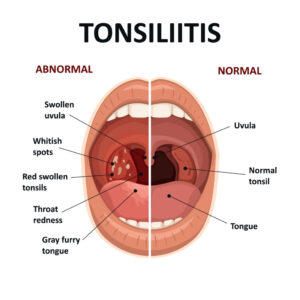Tonsillities
Tonsillitis is the medical term used to describe the inflammation of the tonsils, which are two oval-shaped lymphoid tissues located at the back of the throat. Tonsillitis is a common condition, particularly in children, and it can be caused by viral or bacterial infections.
Viral tonsillitis is the most common form and is often caused by viruses such as the common cold virus, influenza virus, or Epstein-Barr virus (which causes infectious mononucleosis). Bacterial tonsillitis is usually caused by group A Streptococcus bacteria (Streptococcus pyogenes) and is commonly referred to as strep throat.
tissues located at the back of the throat. Tonsillitis is a common condition, particularly in children, and it can be caused by viral or bacterial infections.
Viral tonsillitis is the most common form and is often caused by viruses such as the common cold virus, influenza virus, or Epstein-Barr virus (which causes infectious mononucleosis). Bacterial tonsillitis is usually caused by group A Streptococcus bacteria (Streptococcus pyogenes) and is commonly referred to as strep throat.
 tissues located at the back of the throat. Tonsillitis is a common condition, particularly in children, and it can be caused by viral or bacterial infections.
Viral tonsillitis is the most common form and is often caused by viruses such as the common cold virus, influenza virus, or Epstein-Barr virus (which causes infectious mononucleosis). Bacterial tonsillitis is usually caused by group A Streptococcus bacteria (Streptococcus pyogenes) and is commonly referred to as strep throat.
tissues located at the back of the throat. Tonsillitis is a common condition, particularly in children, and it can be caused by viral or bacterial infections.
Viral tonsillitis is the most common form and is often caused by viruses such as the common cold virus, influenza virus, or Epstein-Barr virus (which causes infectious mononucleosis). Bacterial tonsillitis is usually caused by group A Streptococcus bacteria (Streptococcus pyogenes) and is commonly referred to as strep throat. Causes
Tonsillitis can be caused by viral or bacterial infections. Here are the common causes of tonsillitis:
1. Viral infections: Viruses are the most common cause of tonsillitis. Common cold viruses, including rhinoviruses and coronaviruses, influenza viruses, adenoviruses, and the Epstein-Barr virus (which causes infectious mononucleosis or “mono”), can lead to viral tonsillitis.
2. Bacterial infections: Group A Streptococcus bacteria (Streptococcus pyogenes) are the most common bacterial cause of tonsillitis, commonly known as strep throat. Other less common bacteria, such as Streptococcus pneumoniae, Haemophilus influenzae, and Staphylococcus aureus, can also cause bacterial tonsillitis.
3. Fungal infections: Although less common than viral or bacterial causes, fungal infections, particularly Candida species, can occasionally cause tonsillitis, especially in individuals with weakened immune systems.
4. Allergies: Allergic reactions to airborne allergens, such as pollen, dust mites, or pet dander, can cause inflammation of the tonsils and result in tonsillitis-like symptoms.
5. Irritants: Exposure to irritants like cigarette smoke, air pollution, chemical fumes, or dry air can irritate the tonsils and contribute to tonsillitis.
6. Close contact with infected individuals: Tonsillitis can be contagious and spread through respiratory droplets when an infected person coughs or sneezes. Close contact with infected individuals, such as sharing utensils or drinks, can increase the risk of contracting tonsillitis.
Symptoms
The symptoms of tonsillitis can vary depending on the underlying cause and individual factors. Here are common symptoms associated with tonsillitis:
1. Sore throat: Tonsillitis typically presents with a painful or sore throat. The severity can vary, ranging from mild discomfort to severe pain.
2. Redness and swelling: The tonsils may appear red and swollen. In some cases, white or yellow patches or pus may be visible on the tonsils.
3. Difficulty swallowing: Swallowing may be painful and uncomfortable due to the inflamed tonsils. This can make eating, drinking, or even swallowing saliva difficult.
4. Tonsil enlargement: The tonsils may become enlarged and may partially or completely block the throat, leading to a feeling of a “lump” or obstruction in the throat.
5. Sore or swollen glands: The lymph nodes in the neck may become tender and swollen in response to the infection.
6. Fever: Tonsillitis caused by bacterial infections, such as strep throat, often results in a fever. The temperature can vary but is generally above 100.4°F (38°C).
7. Bad breath: Foul-smelling breath may be present due to the accumulation of bacteria or debris in the tonsil crypts.
8. Headache and body aches: Some individuals with tonsillitis may experience headaches, muscle aches, and general fatigue.
Preventions
While it may not be possible to prevent all cases of tonsillitis, there are preventive measures that can help reduce the risk of infection or minimize the severity of symptoms. Here are some prevention tips:
1. Practice good hand hygiene: Wash your hands frequently with soap and water for at least 20 seconds, especially before eating, after using the restroom, and after being in public places. If soap and water are not available, use alcohol-based hand sanitizers.
2. Avoid close contact with sick individuals: Try to avoid close contact with people who have respiratory infections, such as the common cold or flu. This includes avoiding sharing utensils, drinks, or personal items with individuals who are sick.
3. Cover your mouth and nose: When coughing or sneezing, cover your mouth and nose with a tissue or your elbow to prevent the spread of respiratory droplets. Dispose of used tissues properly and wash your hands afterward.
4. Practice respiratory hygiene: Encourage others to follow good respiratory hygiene, such as coughing or sneezing into a tissue or their elbow, and promptly disposing of used tissues.
5. Strengthen your immune system: Maintain a healthy lifestyle to support a strong immune system. Get adequate sleep, eat a balanced diet rich in fruits and vegetables, exercise regularly, and manage stress levels.
6. Avoid irritants: Minimize exposure to irritants that can cause throat irritation, such as cigarette smoke, air pollution, chemical fumes, and dry air. If possible, use air purifiers or humidifiers to improve indoor air quality and maintain optimal humidity levels.
7. Practice safe hygiene habits: Avoid sharing personal items such as utensils, drinking glasses, or toothbrushes with others to reduce the risk of spreading infections.
8. Vaccinations: Stay up-to-date with vaccinations, including the flu vaccine and other recommended immunizations, to reduce the risk of certain viral infections.

